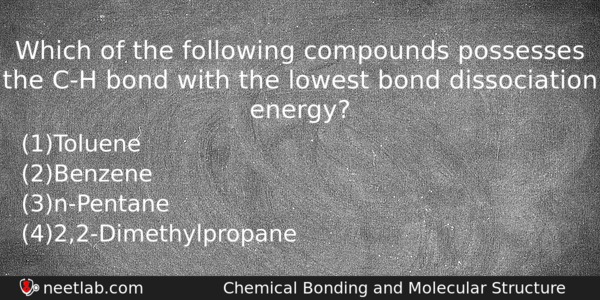| ⇦ | 
| ⇨ |
Which of the following compounds possesses the C-H bond with the lowest bond dissociation energy?
Options
(a) Toluene
(b) Benzene
(c) n-Pentane
(d) 2,2-Dimethylpropane
Correct Answer:
Toluene
Explanation:
Structure of Toluene:
Toluene (C₆H₅CH₃) = 85 kcal/mol
Benzene (C₆H₆) = 110 kcal/mol
n-Pentane (CH₃CH₂CH₂CH₃ ) = 98 kcal/mol
2, 2-Dimathylpropane = 92 kcal/mol
Toluene has the lowest C – H bond dissociation energy compare to other three.
Toluene is a Tertiary free radical. Bond Dissociation Energy of C-H bonds decreases as we go from methyl to primary to secondary to tertiary. They are easier to break since homolytic bond cleavage results in a more stable radical.
Related Questions: - The role of cryolite in the metallurgy of extraction of aluminium is to
- If a is the length of the side of a cube the distance between the body
- If a gas expands at constant temperature , it indicates that
- What is the composition of tear gas
- Silver sulphide dissolves in a solution of sodium cyanide to form the complex
Topics: Chemical Bonding and Molecular Structure
(86)
Subject: Chemistry
(2512)
Important MCQs Based on Medical Entrance Examinations To Improve Your NEET Score
- The role of cryolite in the metallurgy of extraction of aluminium is to
- If a is the length of the side of a cube the distance between the body
- If a gas expands at constant temperature , it indicates that
- What is the composition of tear gas
- Silver sulphide dissolves in a solution of sodium cyanide to form the complex
Topics: Chemical Bonding and Molecular Structure (86)
Subject: Chemistry (2512)
Important MCQs Based on Medical Entrance Examinations To Improve Your NEET Score
18000+ students are using NEETLab to improve their score. What about you?
Solve Previous Year MCQs, Mock Tests, Topicwise Practice Tests, Identify Weak Topics, Formula Flash cards and much more is available in NEETLab Android App to improve your NEET score.
Share this page with your friends

Why the other three options are not correct explain the reason for wrong options
Updated the explanation section with the answer.